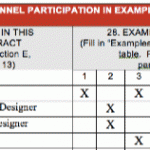Ok, where was I? Oh yeah…
I had made a lot of effort on the website. I created an rfp, shortlisted firms, interviewed, and checked references. But I was left with no feasible designer, no idea of what it would cost, and no website.
Initial Design Concepts
I knew one of the major sticking points would be design. We argue about what looks good to no end. There is not agreement on what looks good in my business world. Frankly, what looks good to you won’t necessarily look good to me, and neither of us know what the client will think of it. Looking good is based on perception and preference. But, I digress.
So I said, give me $500. I’ll hire designers overseas to come up with some concepts. At least we’ll get a sense of what we can agree on. I used the $500 number, but I knew I could get this done for under $500. This is a typical tactic of mine. Ask for slightly more than you know it will cost because you never know the things that you didn’t consider which may end up costing you more than you budgeted. In the construction world, this is called a contingency. I always build some contingency into budgets.
So spending $150, I had two designers on Elance.com come up with 10 design concepts. Sure, the designers were from India. But they were just coming up with preliminary concepts, not the website. There was no coding involved at this stage. The designs came back to me as image files. Here are some of the rejected design concepts:
But one concept stood out with the group almost unanimously. Unanimously, except for me. I didn’t care for it. Here it is:
That general consensus was an opportunity. And that design concept served as the starting point for what would eventually become our new website. Sometimes you have to swallow your pride and defer to the group at large in order to get things done.
Refined Concepts For Each Section
Now that I had a consensus on the general look of our website, I had something to work with. So I worked with the developer through Elance.com to come up with a refined set of templates for our website.
It was important not to do this task with a committee. That would have bogged the whole process down. I worked with the President to come up with a design template (image) for the look of each section of our website. Please note that I had already created a website map with the RFP. So, we used that as a guideline for which sections we would need.
The president and I went back and forth on everything from the width of the website (in pixels), the size of the logo, and how our name would look on the completed website. And while we didn’t always agree right off the bat, we eventually came to agreement on every issue. As a side note, he ended up convincing me more than I convinced him.
Once I had the concept templates, we sent them out to the group. I requested that they identify only significant problems with the design. As I expected, I did get nit picky comments. That’s what engineers do. But since the president had already approved these templates, I was able to ignore those comments. And while that might sound like a jerk thing to do, in the end those nit picky comments have been forgotten. Everybody loves the look of the completed website.
Getting the refined templates cost me $175. I had now spent $325 and had design concepts for the website. Now all I needed was words and the code that would make up our website. GULP!!!
If you remember from the last post, I had been at the SMPS Build Business conference discussing websites with my peers. Those discussions played a huge part in the next phases of the project. But more on that next time.
Share your experiences on how you gain consensus during the design of a corporate website in the comments section. We’d love to hear what you have to say.





Speak Your Mind